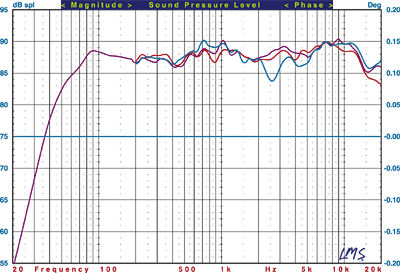Polk LSi9 surround speaker system Measurements
The sensitivity of the Polk LSi9 measured about 87dB/W/m. Its ported cabinet is tuned to approximately 50Hz, with a minimum impedance of 2.5ohms at 52Hz. A small ripple in the impedance magnitude at about 1kHz may indicate the presence of a resonance at this frequency. The impedance remains below 4ohms from 42 to 72Hz, and again from 150 to 290Hz; I would conservatively rate the speaker's nominal impedance at 4ohms. But the phase angle of the impedance is relatively benign; the LSi9 should be of average difficulty to drive.
The pseudo-anechoic response of the LSi9 at tweeter height, averaged over a 30° forward horizontal angle and combined with the nearfield responses of the woofers and ports, is shown in Fig.1 (violet). The useful bass extends down to about 40Hz (–10dB relative to the output at 1kHz). The on-axis average is reasonably smooth, with a small rise at 1kHz and a broader plateau from about 7 to 12kHz. That 1kHz rise corresponds to the wrinkle in the impedance plot noted above. But FM reported no audible anomalies from it, and overall the response is within +/-2dB from 70Hz to 14kHz.

Fig.1: Polk LSi9, pseudo-anechoic horizontal response at 45° (red) and 60° (blue) relative to tweeter axis.
The LSi9's tweeter is asymmetrically positioned on the speaker's baffle. We measured the off-axis horizontal response on the side where the tweeter is closest to the cabinet edge. (The response will be a little different in the other direction, but the offset is small and should not significantly alter the result.) The response at extreme off-axis angles is very well-behaved and stays close to the on-axis response, except for the rapid falloff at extreme high frequencies.
Fig.2 again shows the LSi9's averaged horizontal front response (violet), plus the vertical responses taken at +15° (red) and –15° (blue) relative to the tweeter axis. The vertical listening position appears relatively noncritical within the +/-15° limits, though the small suckout centered at about 2.5kHz may account for the changes FM heard when he positioned himself below the tweeter axis.

Fig.2: Polk LSi9, pseudo-anechoic vertical response at +15° (red) and –15° (blue) relative to tweeter axis.
Fig.3 shows what happens to the LSi9's response at extreme off-axis vertical angles. The point of presenting this curve is that if the speaker is rotated 90° and used as a horizontal center-channel speaker, the red and blue curves will now represent the 45° off-axis horizontal response. The LSi9 could be used this way, but if you're considering using it as a center-channel and can't position it vertically, you might be better off with a vertically positioned LSi7 or Polk's dedicated LSiC center. Our sister publication, Stereophile, tested the LSi7 recently (March 2003); the response curves for that speaker suggest a good spectral match to the LSi9.

Fig.3: Polk LSi9, pseudo-anechoic vertical response at +45° (red) and –45° (blue) relative to tweeter axis.
If the vertically positioned LSi9 is not practical as a center-channel in your system, my choice for an option would be the shorter LSi7, though you might have a problem buying just one. (You could use the extra speaker of the pair as a rear center-channel in a 6.1-channel setup.) Our experience with all of the woofer-tweeter-woofer, horizontally configured center-channels we've measured to date suggests that the similarly configured LSiC will also have off-axis suckouts in its response similar to those in Fig.3. But we haven't tested the LSiC, and so can't say for certain. Readers auditioning such speakers should listen to a wide range of material on them, particularly dialogue. Stay alert for any muffling of the response or loss of dialogue intelligibility as you move as far to the side as any frequently used seating positions in your home. Disconnecting the other speakers in the system will help you to spot this problem more quickly.—Thomas J. Norton
All figures: Violet: Pseudo-anechoic response on tweeter axis, averaged across a 30° horizontal window, combined with nearfield responses of woofers and ports.
- Log in or register to post comments





























































